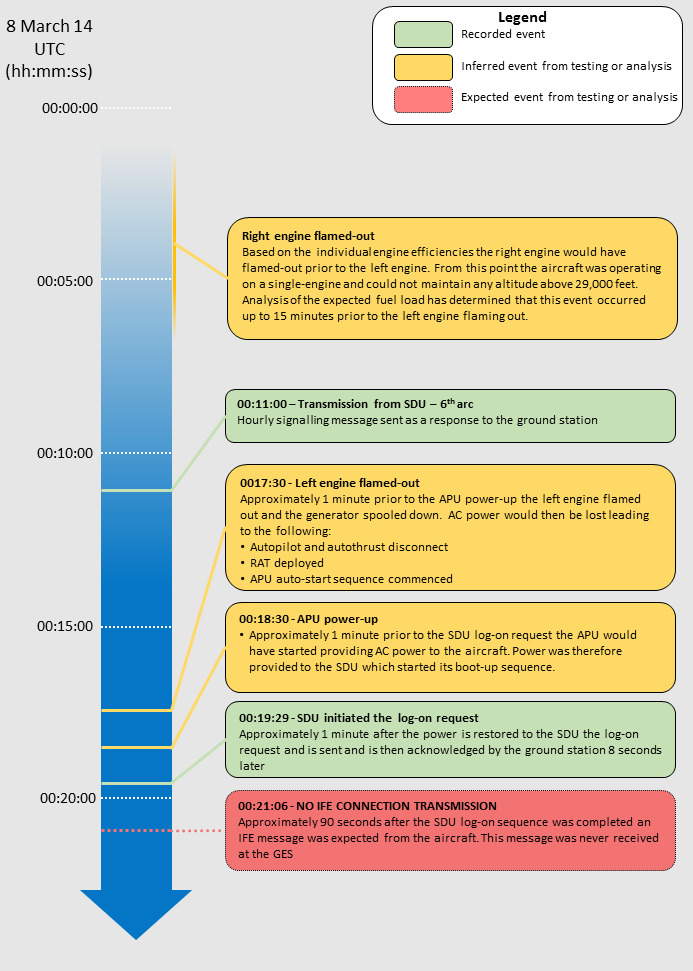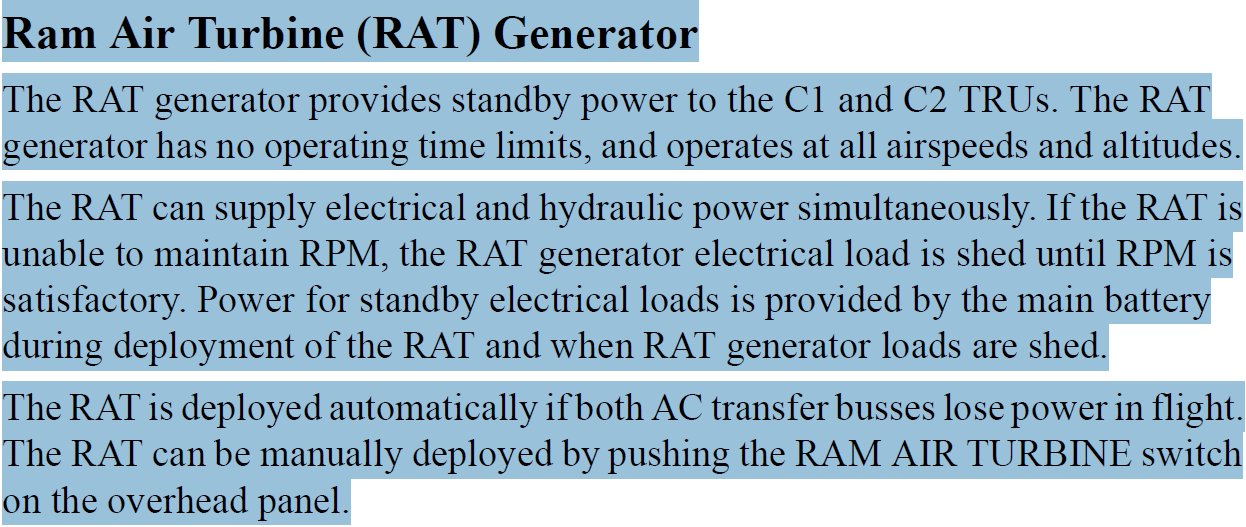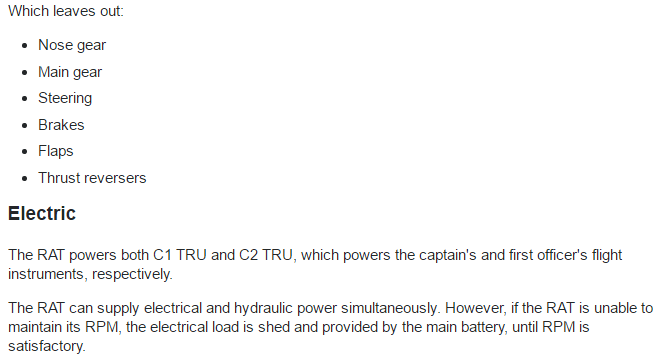Every Breath you Take
Explaining the seemingly Inexplicable MH370 events
Possible in-flight events[edit]
Power interruption[edit]
The SATCOM link functioned normally from pre-flight (beginning at 00:00 MYT) until it responded to a ground-to-air ACARS message with an acknowledge message at 01:07. Ground-to-air ACARS messages continued to be transmitted to Flight 370 until Inmarsat's network sent multiple "Request for Acknowledge" messages at 02:03, without a response from the aircraft. At some time between 01:07 and 02:03, power was lost to the SDU. At 02:25, the aircraft's SDU sent a "log-on request".[42]:22[44]:36–39 It is not common for a log-on request to be made in-flight, but it could occur for multiple reasons. An analysis of the characteristics and timing of these requests suggest a power interruption in-flight is the most likely culprit.[42]:33[167] As the power interruption was not due to engine flame-out, per ATSB, it may have been the result of manually switching of the aircraft's electrical system.[42]:33
In the Wikipedia entry for MH370 (see above and http://tinyurl.com/j4ztdks ) it is mentioned that the flight-following InMarsat satellite stationed above the Indian Ocean sent multiple half-hourly handshake requests to MH370 without any response - for an extended period, before coming good.
|
Australian investigators have
discovered evidence of a mysterious power cut during the
early part of the missing Malaysia Airlines MH370 flight
.The findings by the Australian Transport Safety Bureau
raises questions over whether the plane's cockpit equipment
had been tampered with, possibly in an attempt to avoid
being picked up by radar. In the report, crash investigators reveal that the missing Boeing 777's satellite data unit had unexpectedly tried to log on to a satellite, around an hour and a half after the flight left from Kuala Lumpur on March 8. This request, known as a 'handshake', was likely to have been caused by a power failure on board, the 55-page report says. 'A log-on request in the middle of a flight is not common and can occur for only a few reasons,' the report states'. These include a power interruption to the aircraft satellite data unit (SDU), a software failure, loss of critical systems providing input to the SDU or a loss of the link due to aircraft attitude. 'An analysis was performed which determined that the characteristics and timing of the logon requests were best matched as resulting from power interruption to the SDU.'
Aviation safety expert David
Gleave from Loughborough University says the power
interruption could have been caused by someone in the
cockpit trying to turn off the plane's communications
systems to avoid being picked up by radar. 'It could be
a deliberate act to switch off both engines for some
time,'
'By messing about within the cockpit you could switch off the power temporarily and switch it on again when you need the other systems to fly the aeroplane.' He added: 'There are credible mechanical failures that could cause it. But you would not then fly along for hundreds of miles and disappear in the Indian Ocean.' British satellite telecommunications company Inmarsat has confirmed there was a power outage on the plane, but has been unable to say why this happened. |
It's concluded that "at some time" between 0107L and 0203L, power was temporarily lost to the SDU (Satellite communication system Data Unit ) - and permanently to the ATC transponder. As 9M-MRO had not suffered a flame-out and was still underway, it was easily concluded that these units had been "manually switched off".... giving impetus to the populist "illegal interference" theory. No-one at Boeing put their hand up with any other alternative "systems"-based explanation. It's as if there was a technical blackout at 777 HQ. A hushed silence prevailed as Boeing's execs and techs pursued their own inhouse agenda for "questing" likely explanations and any associated litigational vulnerability for the Boeing Colossus.
So, might there be another reason for this interim and temporary (and event-coincidental) outage? It's already been described that the flame-front of an oxygen enrichment DDT flash-over would have many indeterminate physical effects upon the plastics-based switchology, keypads and touch-screens of the flight-deck - and the much disregarded singular point of non-redundancy for many systems - i.e. that human interface of their ON/OFF switches. In many respects you can compare an oxygen enrichment flash-over to an Electro-magnetic pulse (EMP). However, even though a flash-over on a flight-deck might be micro-cosmic by comparison, it's also a very transitory systems-crippling major upset that can leave, in addition to the depressurisation, a chaotic electrical disordering in its wake. 777 Electrical system operation is automatic and faults are automatically detected and isolated. But in a designer's mind, failures aren't daisy-chained together - so little provision is made for accommodating them, despite the No-break power transfer technology and mutually supportive bells and whistles. Electrically held relays are used in the 777 because they are simpler and more reliable than the magnetically latched type. But they are vulnerable to large scale electrical disruption. One characteristic of a flash-over induced arcing of a wire-bundle is that it can defeat a circuit breaker's ability to protect downstream systems. In other words, there's no guarantee that a thermal circuit-breaker will trip once a wiring loom (or bundle) arcs. You can end up with a contaminated supply flux on that circuit or buss - as far as volts amps and frequency (i.e. cycles) are concerned. You can also end up with an induced Flight Management computer reboot..... which could also explain the interim SDU outage. Some systems are very power-supply frequency sensitive, the SDU and its software load likely being one of them. I doubt very much that even a mishandled smoke and fumes checklist could cause an SDU outage or FMC reboot.
It's not known whether there are any self-resetting circuit-breakers in the 777's electrical architecture, or any AFCI circuit-breakers (arc-fault circuit interrupts), but there is a "hierarchy of needs" embedded within the 777's highly complex electrical system's design and construction. ETOPS aircraft need hardened systems. This sophisticated system contains many "work-arounds" in the shape of generator supervisory panels, bus-tie switches and a sprinkling of load-shedding devices, each with its own tripping thresholds for electrical load-shedding and transfer. ELMS (the Electrical Load Management System) decides which systems get the power and which should be monitored off. There is also the BEPS (backup electrical power system). Many of these load-shedding pathways aren't "one-way streets" (i.e. some systems can sample their input power supplies, test their ability to reconnect - and in some cases will do so, once volts, amps and cycles fall within their own sub-systems' protective parameters (much as they do on their BITE test after initial aircraft ground power or APU power-on).
| At 17:07:29, the plane sent an ACARS report via its
satcom. At 17:20:36, five seconds after passing waypoint
IGARI and a minute after the last radio transmission, the
transponder shut off (i.e. the time of the
"event").
For the next hour, MH370 was electronically dark. The next
ACARS transmission, scheduled for 17:37, did not take place
(see box below for a likely reason why).
At 18:03 Inmarsat attempted to forward an ACARS text message
and received no response, suggesting that the satcom system
was turned off or otherwise out of service. At 18:22, MH370
vanished from primary radar coverage over the northern Malacca
Strait. Three minutes later the satcom system connected with
Inmarsat satellite 3F-1 over the Indian Ocean and initiated
a logon at 18:25:27. One explanation for the time taken to log back on could well be "the loss of the link due to aircraft attitude". Whilst inside cloud and being tossed around, it's quite possible that the attitude at the relevant times (every 30 minutes) was momentarily outside the aspect limits for the antenna [just forward of the vertical fin]. |
Generators power busses and busses are segregated, rated and prioritised in a pecking order dependent upon their subsystems' criticality for flight. Critical systems such as the primary flight controls (for instance) can be powered by alternate combinations of busses. These are characterised as ESSENTIAL busses and are further sub-divisible into single phase AC, three phase AC and rectified DC power. "Essentiality" is best characterized as a "fall-back", fault-tolerant and fail-safe system logic. This vital redundancy factor is in stark contrast to galley power, Inflight Entertainment systems and cabin bus lighting priorities. Those non-vital services reside upon non-essential busses. The SDU would logically lie somewhere midway between vital and "sheddable" in that risk-spreading hierarchy of needs. It could reconnect if its parent bus comes back on-line or if parameters fall within limits as other systems fail due to ongoing arcing - and are then monitored OFF.
What might have happened to cause the SDU power outage is easily part of the oxygen flash-over theory and its EMP effect upon volts, amps and cycles in 9M-MRO's electrical system - as controlled by the BPCU (Bus Power Control Unit). Therefore I personally favour the Flight Management computer reboot as emanating from the electrical maelstrom that resulted from that electrical systems crippling flash-over vulnerabilities and consequential bus-switching. That reboot happened yet again some six plus hours later when the flame-out occurred and there was a slight hiatus until the APU started, its generator came on-line and the InMarsat sign-on hand-shake for 9M-MRO was triggered. In flight, when no other power source is available, the APU will self-start and power Left and Right busses, regardless of transfer switch positions.
i.e. in Wikipedia:
" The ATSB investigators also reported that a second mysterious "handshake" request occurred nearly six hours later. This one, they speculated, was caused by fuel exhaustion and power loss before the plane crashed into the Southern Indian Ocean."
And of course, if you subscribe to the theory of the Flight Management computer reboot, you may also prefer to see that as being the autopilot OFF initiator at flash-over and the radar-registered climb to 40Kft as being just what the airplane might do during that FMC reboot period - until everything input/output-wise was nulled out and reset. Only Boeing and their inhouse "iron bird" simulator could tell you for sure, and they're keeping "mum" on this. But I like this alternative theory because I'm just not seeing either pilot having survived that 10 to 15 second oxygen enrichment flash-over (as witnessed by Mike McKay the oil-rig worker) - or either pilot doing anything survivalist pursuant to its snuffing. But you never know..... adrenaline is a real kicker.
A Solution to yet Another MH370 Mystery
I latterly realized that I hadn't directly addressed this issue of the satcom going "dark" during the period spent within the ITCZ after its course reversal towards Pulau Langkawi (another "unexplained mystery" according to the official narrative). Hopefully my explanation below will serve to clarify what was likely to have been the reason "why" it went dark and then later revived its SATCOM responsiveness at the start of its long trek to the south.
In case anybody should contest the assertion that 9M-MRO could not have recovered its poise after each CB encounter without an autopilot, the answer is simply that, as long as the FMC wasn't locked onto a selected heading or particular FMC-based tracking directive, the explanation for each of its new CB Cloud "spat-out" trackings still works for autopilot/auto-throttle ON - as well. It's just a "no-matter which" (...was the case) proviso. i.e. It works either way.
Forty minutes after the plane took off from Kuala Lumpur, MH370 went electronically dark, just after signing off with KL ATC. For about an hour after that, the aircraft was tracked on primary radar via its "skin-paint". ... after its reversal of course, some mystery zigzags and while still traveling quite fast. Then it suddenly disappeared from military radar..... probably due to terrain masking of the radar head. Three minutes later, now somewhere SW of the tip of Sumatra and unmasked by terrain but outside radar range, 9M-MRO settled down onto a final (and terminally steady) southerly course, the communications system logged back onto the satellite. This was a major revelation. This event corresponded with the first successful half-hourly satellite ping interrogation ... since the turnback event. Over the course of the next six hours, 9M-MRO remained on that steady southerly course and generated six more satellite handshakes.
 |
Why hadn't the aircraft logged on during the prior half-hourly attempts by the satellite to seek a log-on by MH370 (i.e. at the 30 minute satellite interrogative ping after the turnback)?" The answer may well be quite simple. Many such mysteries are. During its time over the Malay Peninsula, later on in the Straits of Malacca, and until west-bound around the tip of Sumatra, MH370 was embroiled in regular classic ITCZ severe weather encounters and after each one, was being spat out on a new heading - and obviously took some time (after each encounter) to regain its stable composure. In other words, at the exact time of each half-hourly solicitous ping from the satellite, MH370 was likely in cloud, pitching and rolling and having a "tangle with the angle". The satcom (aka Satellite Data Unit or SDU) cannot remain locked on (or be receptive and compliantly responsive to satellite ping initiation routines) when in any sort of unusual attitude for any finite period - i.e. due to being inside (or just exited/spat out from) a cumuloNimbus - and those nasty clouds are typically massive and dense in that ITCZ band. Successful handshaking sequences require a period of stable non-manoeuvring flight within the line-of-sight limits of the SDU's antenna (located atop the fuselage and just forward of the vertical fin). A bank angle of greater than 30 degrees will mask that antenna's required electronic view of the heavens. Until 9M-MRO escaped that 300km wide band of activity on its southerly track, it was destined to blunder into heavy weather inside convective cloud build-ups - CumulNimus clouds that can extend up to 55,000 ft.
But many hours later, the final handshake at the 7th arc wasn’t completed. The interchange of data was OK until it suddenly stopped short of logging on the IFE (Inflight Entertainment System) and completing a BITE exchange of validation data. This led to speculation (later endorsed by trials and SDU manufacturer input), that MH370 had run out of fuel and lost power, causing MH370 to abruptly and finally lose its connection to the satellite. The APU had previously started after both engine-driven IDG generators had shut down, taking 60 seconds to start and bring its own generator online to provide power for the satcom unit to initialize its own internal reconnection routine, just before the plane crashed. However only around 30lbs maximum of fuel were trapped in the feed-lines between the (now empty) LH main tank and the APU. However this fuel is being sucked through by the APU and that feed continuity being vulnerable to aircraft attitude change, the APU flamed out also - after less than 3 minutes of glide (see the graphic).
|
Ditching considerations (from the ATSB Conspectus) A controlled ditching scenario requires engine thrust to be available to properly control the direction and vertical speed at touchdown and to provide hydraulic power for the flight controls including the flaps. The final SATCOM transmission was considered by the satellite working group to be due to a power interruption to the SDU. Given the performance analysis by Boeing, it is entirely reasonable to assume that engine flame-outs triggered the APU auto-start that restored power to the SDU and enabled an almost completed aircraft-initiated log-on. This evidence is therefore inconsistent with any controlled ditching scenario. |
The only source of power was then the battery BUS and the Ram Air Turbine (the RAT), dangling from its compartment below the fuselage.
Where exactly MH370 would have gone down was then dependent upon its flight path subsequent to the second (LH or port) engine's flame-out. This indeterminate variable has played a large part in a scholarly determination (and some ongoing revisions) of the sea-bed search area astride the 7th Inmarsat arc.
 |
 |